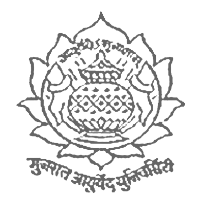Article by Kerstin Rosenberg
Even before today's climate chaos and global warming, ancient Ayurvedic scriptures warned of the dangers our bodies face with the changing seasons. According to the different climatic zones, our body fluids (Doshas), metabolic functions (Agni) and life forces (Bala) react to the changing weather and temperature conditions with immune deficiency, digestive disorders or emotional imbalance. This is especially noticeable in winter with colds, depressive moods and flu-like infections. Here, simple Ayurvedic dietary and herbal recommendations can help to stabilize the physical and mental balance.
In order to strengthen the health of the individual throughout the year, the Ayurvedic health teachings (svasthavritta) give precise instructions for the right behaviour and an appropriate diet. Ayurveda describes six different seasons (ritucarya), which do not only have climatic but mainly planetary influences on body and mind.
Ritucarya - Ayurvedic health tips for each season
| Early Winter Hemanta Ritu | October 22 - December 21 | Now the metabolism (Agni) is very strong as it is kept going by contact with cold wind and is well able to digest heavy food. Oily food with enough dairy products, cereals and honey is especially good now. |
| Late Winter Shishima Ritu | December 22 - February 21 | In late winter, the body builds up Kapha to protect against cold and emaciation and to strengthen the immune system. For inner warmth and stability, only warm, cooked foods with stimulating spices should be consumed, and hot water and a glass of wine should be drunk in the evening. |
| Spring Vasanta Ritu | February 22 - April 21 | In the spring we should purify ourselves: Short periods of fasting are advisable. Daytime sleep as well as heavy, sour and sweet food should be avoided. Instead, physical exercises, dry massage and regular consumption of barley, millet and ginger water are recommended. |
| Early Summer Grishma Ritu | April 22 - June 21 | In early summer, consumption of sweet, cold, liquid and oily-fatty foods and drinks is recommended. Sour, salty, spicy and hot foods and alcoholic beverages should rather be avoided. |
| Late Summer Varsha Ritu | 22 June - 21 August | Now the digestion works comparatively weakly. We have high Pitta but little Agni available. To avoid depletion, a moderate lifestyle should be adopted by avoiding excessive sun, sex and physical exercises. For internal strengthening, it is advisable to eat plenty of honey and make the daily meals of light vegetables, fresh salads and herbs and cold-pressed oils. |
| Autumn Sharada Ritu | 22 August - 21 October | In autumn Pitta is strong again and we have accumulated a lot of inner heat, which gives us a lot of energy and drive. Unfortunately, the skin and digestive organs can now also react with typical Pitta disturbances such as burning, redness or inflammation. Therefore, sweet, light, cold and bitter foods and drinks are recommended along with rice, barley, wheat and ghee. |
Braving the winter season
Winter time is particularly challenging for our physical and mental strength. Here our three doshas vata, pitta and kapha have to completely re-sort themselves and the digestive fire (agni) needs a strong impetus to stand up to the wet and cold weather. This is because in winter, the cold qualities in the form of vata and kapha increase by leaps and bounds. This also promotes susceptibility to physical and mental imbalances such as fatigue, heaviness, depression and all kinds of respiratory and cold disorders. So if you want to escape the obligatory cold or flu, you should be wary of the excess of these cold-prone doshas and, above all, dress warmly enough. It is not for nothing that the disease name "cold" is derived from cold: All cold qualities of climate, but also of food, drive our Vata and Kapha up and invite colds. In Ayurveda, these are assigned to various leading symptoms, such as the common cold (pratishyaya), cough (kasa) and shortness of breath (shvasa), and are usually caused by the accumulation of too much Vata and Kapha.
Depending on our constitution and habits, we are more prone to Vata-type colds - which are accompanied by dry cold and roughness - or to Kapha accumulation, which manifests itself in damp cold, accumulation of mucus, heaviness and dullness. So the first thing to do in self-diagnosis is to determine whether we are suffering from a Vata cold - with dry cough, rough mucous membranes, tension pains and immune deficiency - or a Kapha cold with a thick nose and watery eyes, tiredness and aching limbs. In the further course, Pitta complaints such as inflammation or fever can turn the cold into a full-blown flu. According to these different symptoms, different dietary recommendations and herbal formulations are used for prevention and self-treatment.
Cold symptoms with dosha reference
| vata | pitta | kapha |
| - thin secretions - dry mucous membranes - sneezing - dry intense cough - hoarseness - shortness of breath due to constriction of the airways - pain - cold sensations - weakness - sudden onset and rapid progression of the illness | - the inflammatory component is in the foreground - reddening of the mucous membranes - yellowish-greenish secretions (pus formation) - feeling of heat or fever - thirst - burning sensation | - Thick, sessile secretions - Moist, productive cough - Shortness of breath due to congestion of secretions - Feeling of cold - Tiredness and heaviness - Slow development of symptoms |
Type-specific recommendations for each "cold type
According to our individual constitution we are prone to the typical cold symptoms: Especially Kapha constitution are prone to colds, coughs and shortness of breath in wet and cold temperatures. An excess of phlegm, accompanied by tiredness and depressive mood is now at the heart of the illness process and heralds the "winter blues" for many sufferers. Vata types are also more frequently affected by colds. They have a certain immune deficiency, which is promoted by a debilitating lifestyle and a poor diet. Pitta constitutions are least susceptible to colds due to their natural warmth. They are more likely to develop inflammatory processes in the respiratory tract, such as tonsillitis.
Dosha-typical causes for colds also from an Ayurvedic point of view:
- cold wind (rather vata-increasing) - cold wetness (kapha) - physical and mental overload (vata; weakening the defense) - suppression of the natural cleansing reflexes such as the urge to sneeze and cough, yawn, urge to urinate and defecate, etc. (vata) - irritation of the respiratory tract (e.g. smoking, dust; vata) - cold food (vata, kapha) - hard-to-digest food (blocks the pathways; agni and defence weakening; kapha) - nutritional deficiencies (vata, kapha; agni and defence weakening)
Recommendations for doshas balancing
| Dosha | recommendable qualities | recommended taste of food | Recipe example for winter |
| Vata | light, warm, soft, moist, calming | sweet, salty, slightly sour, slightly hot | Fine creamy soup of root vegetables (carrot, parsnip, potato) with cream, soy sauce and ginger |
| Pitta | cool, mild, less cooked, heavy | sweet, bitter, astringent | Bean soup, potato gratin, cabbage vegetables with fresh herbs |
| Kapha | light, warm, dry, stimulating | spicy, bitter, astringent | Rice, mungdal with spinach, spicy vegetable curry |
With Ama or without Ama?
Despite all the differences according to type, there are some important similarities in the prevention and therapy against colds: Whenever a cold or flu is in the offing, it is synonymous with the blockage of the srotas (pathways), especially those that carry on the breath (prana = breath of life). The so-called prana-vaha-srotas are localized as transport spaces and functions in the respiratory tract and are responsible for the exchange of gases. Also manifested here are the Kapha and Vata parts in the body, which leads to a sensitivity to cold and phlegm. Then metabolic waste products (Ama) are also deposited in the Srotas. These lead to a blockage of the respiratory tract and accelerate the disease process. Thus a simple cold quickly turns into an infectious cold.
If we want to take action against ama as a disease trigger, the right diet plays a decisive role. Not only does it protect us preventively, but it can also contribute significantly to the healing of acute complaints. Sometimes just a change in diet, rest and sufficient warmth are enough to cure colds. The principles for an Ayurvedic anti-cold diet are simple: all cold and hard-to-digest foods should be avoided, as should acidic and mucilaginous foods.
So what does this mean in practice?
Particularly in the early stages, when a cold is just coming on, it is advisable to take a small "light diet". Cheese, butter, meat, eggs, fish, cakes, very fatty or raw foods should be avoided for a while and warm vegetable soups and stews with pulses should be preferred instead. If we do not do this, Srota blockages and ama formation are pre-programmed, which burden the metabolism weakened by the cold and settle in the respiratory tract. Here now hot ginger tea and somewhat more sharply spiced courts with much sheet and root vegetables help particularly well. The most beneficial are one or two days of fasting with lots of hot tea, possibly with spiced vegetable soups or other light vegetable dishes (e.g. from courgettes, pumpkin, carrots, aubergines, turnips, beetroot, onions, in moderation also potatoes and rice). This promotes the inner fire (agni), which is often weakened in the early stages of disease and thus involved in the expression of symptoms.
Contrary to the widespread opinion that the consumption of citrus fruits is helpful for strengthening the immune system, Ayurveda is rather cautious with acidifying foods in many diseases. According to classical Ayurvedic textbooks, they irritate the mucous membranes, promote inflammatory reactions, constrict the pathways and create an environment throughout the body that is detrimental to the healing process. Thus, in the case of colds, Ayurveda would not support excessive vitamin C intake in the form of acidic fruits. Acidified dairy products, acidified bread, tomatoes, vinegar and most convenience foods contain a lot of acid. This is especially true when the inflammatory component or pitta expression is prominent. Rather, Ayurveda would advocate the increased intake of bitter foods and remedies. The bitter taste creates a milieu in the body which causes bad living conditions for various pathogens (bacteria, viruses, fungi). This can be supplemented by tart spices and medicinal herbs, such as turmeric and mugwort, as well as hot spices such as black pepper, long pepper, ginger, cloves and cinnamon. These really heat up the metabolism and cleanse the channels and airways. As a special food against colds a honey of good quality is appreciated, especially liquid forest honey with bitter and sharp component, is recommended.
As further prevention, regular nasal rinses with warm salt water and lining the nasal mucous membranes twice a day with two drops of warm sesame oil or ghee (clarified butter) have proved effective. In acute rhinitis, however, these applications should be refrained from; they increase the mucus. Inhalations, on the other hand, loosen the mucus and usually have an immediate soothing effect. However, they must be repeated several times a day (up to four times), as their effect is not long-lasting (1-2 tablespoons of seeds to one litre of boiling water). Inhalation with Ajwain (Trachyspermum ammi) seeds, which are available in any Asian store, is especially good for horsetail and sinus problems. Ajwain smells like thyme and has a kapha- and vata-reducing, disinfecting and antispasmodic effect on the respiratory tract. Thus, inhalations should be done for actually all respiratory diseases, even if they affect deeper regions.
With medicinal herbs, colds can be tackled in a much more targeted manner. For this, however, one must differentiate the symptoms exactly and should be familiar with medicinal plants. Some simple remedies are described below, especially spices that are available almost everywhere and show good results for colds. They may be taken singly or in combination.
Cloves are particularly suitable for prophylaxis, but also acutely support the healing process. They promote mucus reduction, decongest the respiratory tract and have proven effective in various respiratory diseases. As a preventive measure, simply chew a clove several times a day during the cold season or, better still, prepare a tea: boil 5 - 10 cloves in a litre of water, covered, for 10 - 20 minutes and enjoy hot throughout the day.
Turmeric (turmeric) is an excellent remedy for colds and weakened defenses, both for prevention and in the early stages and flanking treatment. It is warming and 'cleanses the blood'. Especially by its bitter taste it has a positive effect on all forms of pathogens, is quasi 'antiseptic'. It is anti-inflammatory, analgesic and detoxicating. It is often used as a gargle for tonsillitis. Generally, however, the powder is used internally in a dosage of 2 - 3g 2 x daily with warm water half an hour before a meal.
Ginger is also spicy, warms and promotes metabolism. It also relaxes the respiratory tract and tones the voice. Especially in the early stages of colds, ginger should be taken in all forms (as a powder with honey, as a tea, as a spice), but it is particularly good to use half a teaspoon of fresh grated ginger with a pinch of rock salt shortly before meals, if necessary with a few drops of the juice of an organic lemon.
Licorice takes an important role in colds. It reduces all three doshas, but should be used with caution in cases of pronounced kapha dominance. It is a restorative remedy (rasayana), strengthens and harmonises the psyche. It has a particularly soothing effect on the throat in cases of hoarseness and sore throat. It is expectorant and can therefore also be taken for processes deeper in the bronchial tubes: as a tea 1 - 2g 2 - 3x daily or chew the coarse root pieces. It is a kind of "mucous membrane care".
Calamus (Vaca = Acorus calamus) is available in the pharmacy. This pungent tuber strongly reduces kapha, but should only be taken cautiously with dominant pitta. It 'scrapes' the kapha out of the airways and dilates the bronchi. As a calming, nervine herb, it is therefore particularly good for bronchial asthma. It is also good for the voice and relieves pain. The powder is dosed low: 0.5g 2-3x daily with honey.
Vasa = Adhatoda vasika is the classical medicinal herb in Ayurveda for diseases associated with cough and shortness of breath (e.g. bronchitis, bronchial asthma). Thus, it is to be preferred when the symptoms have descended into deeper regions of the respiratory tract. It reduces kapha and pitta, is very bitter, worm-promoting and dilates the bronchial tubes. However, it is only available in ayurvedic mail order shops. The dosage of the powder would be 3-5g 2-3x daily with honey. It is also available as a medicinal liquor.
Indian frankincense (Shallaki = Boswellia serrata) has caused a sensation among experts in the treatment of joint diseases. It is currently the subject of intensive research. However, it is little known that it is also particularly recommended for the respiratory tract with its anti-inflammatory, wound-healing and pain-relieving effects. It is expectorant, reduces kapha and pitta, and has been shown to increase local defenses in the respiratory tract. It is recommended for chronic inflammatory and suppurative diseases of the deeper respiratory tract (1-3g purified powder of the resin 2-3x daily).
Bibhitaka (Terminalia bellirica) is a famous tonic (rasayana) in Ayurveda and part of the Triphala ("the three fruits") combination. It is warming and reduces all three doshas. It has this invigorating effect especially in bronchitis and bronchial asthma. It is often given in combination with other remedies for the respiratory tract. The powder is safe to take as a dietary supplement in a dosage of 3-6g 2-3x daily with honey and is available from specialist retailers.
Recipes











